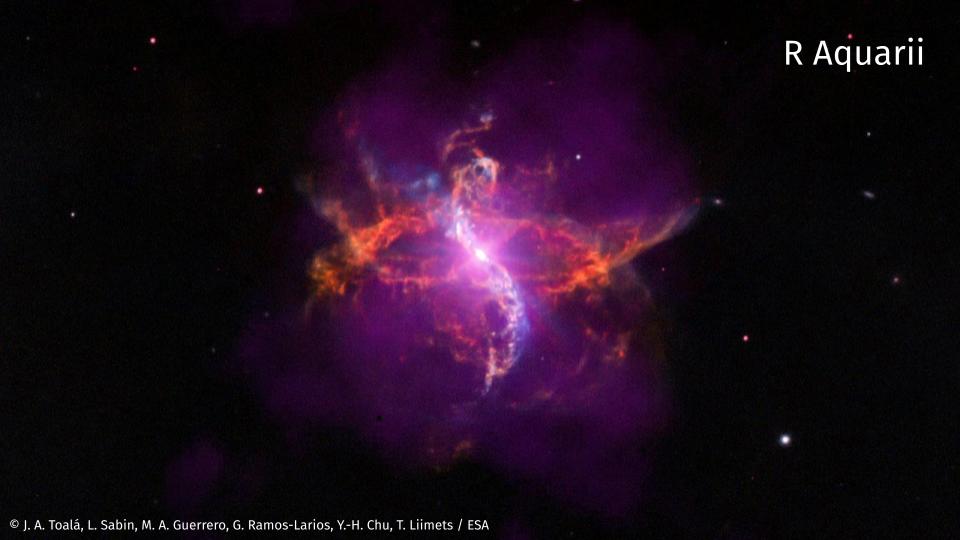A pair of interacting stars is surrounded by a nebula that is so peculiar that it resembles an active galaxy hosting a supermassive black hole when observed in X rays, but smaller. The double star, called R Aquarii, was studied by an international team of astronomers led by Dr. Jesús Toala from the Institute of Radio Astronomy and Astrophysics, National Autonomous University of Mexico (IRyA, UNAM).
"R Aquarii is surrounded by an exquisite hourglass-shaped nebula that shows numerous knots, filaments and cavities, and in its central regions we see the S-shaped jet also presenting knots with a more intense X-ray emission," said Dr. Toalá.
R Aquarii is a binary system of stars formed by a red giant, a solar-type star that exhausted its hydrogen fuel and expanded, and a white dwarf, the exposed core of a star that ejected its outer layers. The red giant pulses every 385 days, brightening and expanding its envelope, while the white dwarf has a disk through which it steals material from its giant companion, and a double jet emerging from its pole that frees the remaining gas.
This type of double stars are known as a symbiotic stars. The X-ray analysis in this study shows that the jet coming from the white dwarf has characteristics that resemble the jets produced by supermassive black holes in the cores of active galaxies.
“This peculiar sys tem of stars has configured an equally peculiar morphology, where all components seem to be interconnected: the mass loss of the red giant, the accretion onto the white dwarf and the development of intricate forms”, continued Dr. Toalá.
Located about 650 light years from Earth, R Aquarii is one of the best studied symbiotic stars. Some features of its nebula seem to have been caused by past explosive events: enough material accumulated in the surface of the white dwarf to start hydrogen fusion, which pumped energy and gas to space and produced a ring of material in 1073, an later the 1770’s decade, both observed with optical telescopes.
X-ray satellites have also allowed astronomers to go deeper into how this system works. “Thanks to the Chandra satellite it was corroborated that material is indeed falling onto the white dwarf, and that the X-ray bright nodules are due to the precession of the jet: the rotation axis of the white dwarf shifts gradually, so the spatial distribution of the X-ray emitting gas changes every few years–thus the S-shaped bipolar jet, also. Given the potential of studying this object in X rays, we re-analized observations from the XMM-Newton satellite that had been ignored since 2005”, said Dr. Martín Guerrero from the Instituto de Astrofísica de Andalucía (IAA-CSIC), Spain, who was part of this work.
Using specialized techniques, the scientists were able to show the presence of X-ray emitting gas extended along the whole nebula, and found that it has physical and chemical properties similar to the gas in one of the nodules in the jet, suggesting that the jet feeds the extended hot bubble seen in X-rays.
Moreover, the nebula is also shaped by the precession angle that produces the S shape in the jet: “Theoretical predictions suggest that with angles greater that 40 degrees the nebulae formed have a pair of extended bubbles, and in R Aquarii we see an angle of about 50 degrees. So, we suggest that the blister-shaped structures observed at the ends of the jet disintegrate and feed the more extended bubble with hot gas. It would be a similar process, though in a smaller scale, to the creation of hot bubbles in active galaxies hosting supermassive black holes”, concluded Dr. Jesús Toalá.
Image
The image shows in purple the gas with a temperature of millions of degrees, observed in X-rays by the XXM-Newtons satellite. Other colors show the optical emission observed by the Very Large Telescope in Chile.
Credits: J. A. Toalá, L. Sabin, M. A. Guerrero, G. Ramos-Larios, Y.-H. Chu, T. Liimets / ESA.

Dr. Jesús Toalá’s career
Dr. Jesús Toalá obtained his Bachelor in Physics degree from the Autonomous University of Sinaloa, Mexico, and his PhD in astrophysics at the Instituto de Astrofísica de Andalucía (IAA-CSIC) in Granada, Spain. He was a postdoctoral researcher at the IAA-CSIC and at the Institute of Astronomy & Astrophysics, Academia Sinica (ASIAA) in Taiwan. He has been a researcher at IRyA UNAM, Mexico since June 2017.
He studies the circumstellar medium around low and high-mass stars through infrared, optical and X-ray observations. He also studies the X-ray emission from superbubbles in the Large Magellanic Cloud.
Dr. Toalá organizes the meetings of the Evolved Stars working group at IRyA, and is a member of the editorial board of the UNAM Campus Morelia Bulletin.
Scientific paper
This research article was published on March 8, 2021 in The Astrophysical Journal Letters.
An XMM-Newton EPIC X-Ray View of the Symbiotic Star R Aquarii
https://iopscience.iop.org/article/10.3847/2041-8213/ac589d
About IRyA, UNAM
The Instituto de Radioastronomía y Astrofísica (IRyA), or Institute for Radioastronomy and Astrophysics is an academic unit at UNAM, Campus Morelia, Mexico. We perform high-level and high-impact research in the areas of interstellar medium, star formation, evolved stars, high energy astrophysics, Galactic dynamics and structure, extragalactic astronomy and cosmology. We contribute to the education of high-level human resources through a postgraduate program, and we have close contact with society through diverse outreach programs.
If you are interested in our Institute, visit the English version of our webpage, www.irya.unam.mx/web/en
Media contact:
Dr. René A. Ortega Minakata
Outreach and Science Communication
IRyA UNAM Campus Morelia
Text: Adapted by IRyA UNAM from the original text by Silbia López de Lacalle, at Unidad de Divulgación y Comunicación, IAA-CSIC (Spain).
IAA-CSIC press release (in Spanish):
https://www.iaa.csic.es/noticias/r-aquarii-estrella-simbiotica-con-rasgos-galaxia-activa




